Susan Price's Blog: Susan Price's Nennius Blog, page 9
January 23, 2015
Winter Scene - and Pubowrimo 2
Joan Lennon, author and poet, often gives us beautiful photos - she's given us some this year of the snows in Scotland.
So I'm answering with winter scenes from the Clent Hills, near Birmingham - and invite you along on the walk my friend and I took.
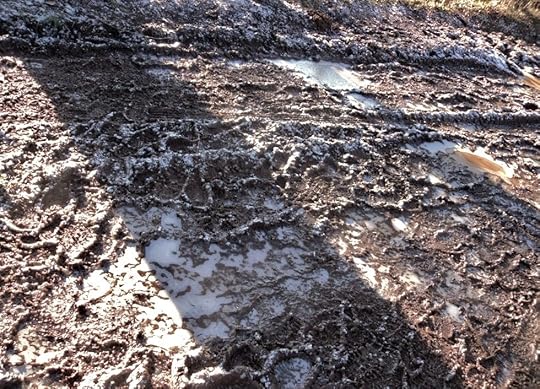 Icy ruts and puddles at the bottom of the hill.
Icy ruts and puddles at the bottom of the hill.
There wasn't a lot of snow, in fact. Much of it was thick frost. But it was proper cold. Colour us blue.
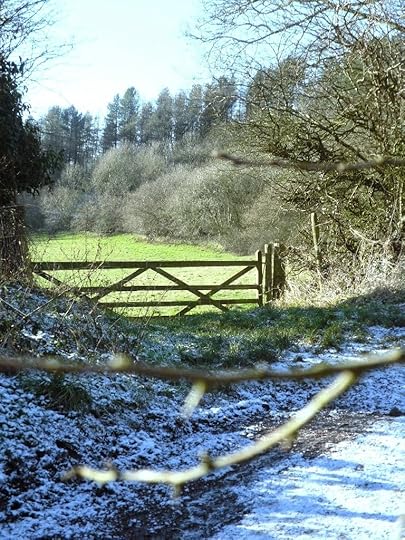 Near the start of the climb.
Near the start of the climb.
 Climbing up - cold but sunny.
Climbing up - cold but sunny.
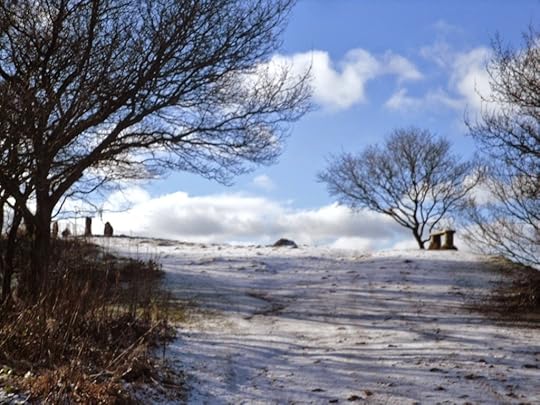 The top of the hill - blue sky and snow
The top of the hill - blue sky and snow
On top of Clent Hill there is an entirely fake stone circle. It's made of concrete. Despite that, it can look quite dramatic.
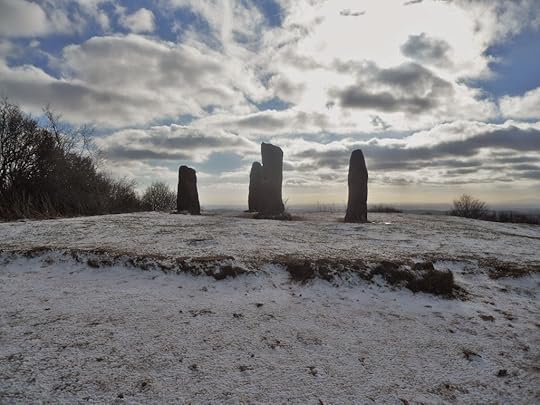 Oooh, but it was taters up there, in the teeth of the wind. We started thinking fondly of the pub.
Oooh, but it was taters up there, in the teeth of the wind. We started thinking fondly of the pub.
 On the way back down, a favourite old tree.
On the way back down, a favourite old tree.
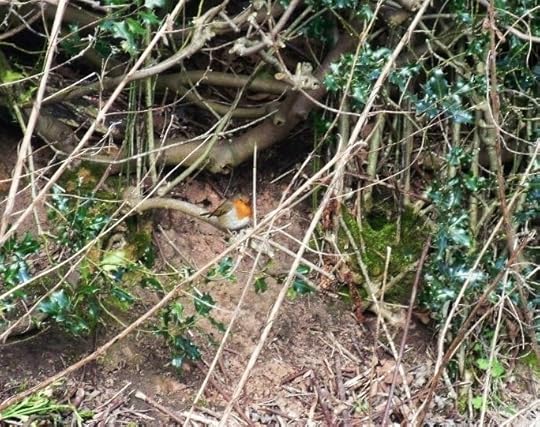 Back at the car we spotted this character on the mooch. He hung about, posing hopefully for quite a while, but unfortunately, we hadn't any mealworms, or even bread, about our persons. Perhaps next time.
Back at the car we spotted this character on the mooch. He hung about, posing hopefully for quite a while, but unfortunately, we hadn't any mealworms, or even bread, about our persons. Perhaps next time.
With cold fingers, toes, ears and noses, we went off to the pub for another pubowrimo. Soft leather sofas, cider, and scribbling on scrap paper or in notebooks. Again, it worked. The friend wrote over 700 words - not as many as last week, he says, because he crossed out a lot. He's still very happy with what he did write, as it's all good, solid progression - and without pubowrimo he probably wouldn't have written it at all.
I'd made a couple of previous attempts at writing my piece at home. It's a part where one character - first person narration - realises that another character is not the nice, ordinary person she took her to be, but, in fact, a malevolent danger to her family - and who has caused most of the trouble they've experienced recently.
The problem was making it convincing that the POV character would come to this conclusion - without making the character herself appear deluded - and keeping the reader engaged while the reasons for the conclusion are spelled out.
I hadn't made much progress at home. I kept thinking, not enough reason! - Boring! In preparation for pubawrimo, I went back through my file and made a list of all the clues that, taken together, might reasonably set alarm bells ringing for my character. I took this list, and the last couple of printed-off pages of my book to the pub with me.

And again, once in the pub with a cider, the words just appeared from whatever strange, subconscious cave they were lurking in. There was some fairly arresting/interesting chat going on at the table near me - "It's by far the best house up there, but it's haunted by the ghost of a child," for instance, said in a completely matter-of-fact way, as if mentioning that the garden was a bit small - but somehow the writing went on despite this, for the full hour.
I managed 2,235 words. I'm not totally happy with it. I think I can improve on it, make it more darkly comic - one of my aims in the book is to make it frightening and funny - but it's something to work with.The words wouldn't be there at all if it wasn't for this exercise.
And my agent is phoning me this week, so useful to have on-going work to talk about.
So I'm answering with winter scenes from the Clent Hills, near Birmingham - and invite you along on the walk my friend and I took.
 Icy ruts and puddles at the bottom of the hill.
Icy ruts and puddles at the bottom of the hill.There wasn't a lot of snow, in fact. Much of it was thick frost. But it was proper cold. Colour us blue.
 Near the start of the climb.
Near the start of the climb. Climbing up - cold but sunny.
Climbing up - cold but sunny. The top of the hill - blue sky and snow
The top of the hill - blue sky and snowOn top of Clent Hill there is an entirely fake stone circle. It's made of concrete. Despite that, it can look quite dramatic.
 Oooh, but it was taters up there, in the teeth of the wind. We started thinking fondly of the pub.
Oooh, but it was taters up there, in the teeth of the wind. We started thinking fondly of the pub.
 On the way back down, a favourite old tree.
On the way back down, a favourite old tree.
 Back at the car we spotted this character on the mooch. He hung about, posing hopefully for quite a while, but unfortunately, we hadn't any mealworms, or even bread, about our persons. Perhaps next time.
Back at the car we spotted this character on the mooch. He hung about, posing hopefully for quite a while, but unfortunately, we hadn't any mealworms, or even bread, about our persons. Perhaps next time.With cold fingers, toes, ears and noses, we went off to the pub for another pubowrimo. Soft leather sofas, cider, and scribbling on scrap paper or in notebooks. Again, it worked. The friend wrote over 700 words - not as many as last week, he says, because he crossed out a lot. He's still very happy with what he did write, as it's all good, solid progression - and without pubowrimo he probably wouldn't have written it at all.
I'd made a couple of previous attempts at writing my piece at home. It's a part where one character - first person narration - realises that another character is not the nice, ordinary person she took her to be, but, in fact, a malevolent danger to her family - and who has caused most of the trouble they've experienced recently.
The problem was making it convincing that the POV character would come to this conclusion - without making the character herself appear deluded - and keeping the reader engaged while the reasons for the conclusion are spelled out.
I hadn't made much progress at home. I kept thinking, not enough reason! - Boring! In preparation for pubawrimo, I went back through my file and made a list of all the clues that, taken together, might reasonably set alarm bells ringing for my character. I took this list, and the last couple of printed-off pages of my book to the pub with me.

And again, once in the pub with a cider, the words just appeared from whatever strange, subconscious cave they were lurking in. There was some fairly arresting/interesting chat going on at the table near me - "It's by far the best house up there, but it's haunted by the ghost of a child," for instance, said in a completely matter-of-fact way, as if mentioning that the garden was a bit small - but somehow the writing went on despite this, for the full hour.
I managed 2,235 words. I'm not totally happy with it. I think I can improve on it, make it more darkly comic - one of my aims in the book is to make it frightening and funny - but it's something to work with.The words wouldn't be there at all if it wasn't for this exercise.
And my agent is phoning me this week, so useful to have on-going work to talk about.
Published on January 23, 2015 16:00
January 16, 2015
Pubawrimo
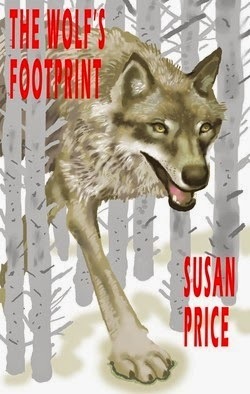 The Wolf's Footprint paperbackHere I am again - and what have I been doing?
The Wolf's Footprint paperbackHere I am again - and what have I been doing?Well, I've been at the self-publishing again. Last year I responded to teachers who emailing me, asking for copies of my OOP book, The Wolf's Footprint. So I reprinted it, as an ebook and as a paperback - and found that the paperback sold more than the ebook.
The obvious lesson to be drawn from this seemed to be - self-publish more paperbacks with CreateSpace. So I've now made all of the Ghost World Sequence - The Ghost Drum, Ghost Song and Ghost Dance available in paperback. And they're selling - as with The Wolf's Footprint - better than the ebooks.
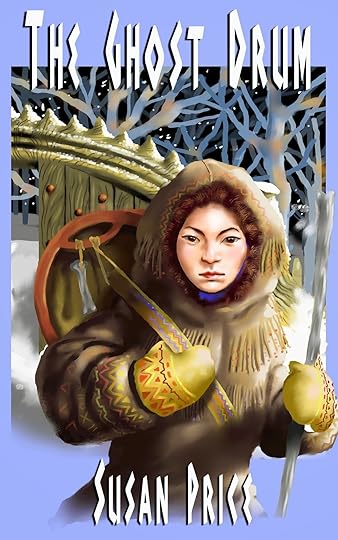 The Ghost Drum
The Ghost DrumSo last week, I worked on Nightcomers, one of my ghost story collections, which contains, I think, some of my best short stories. 'Beautiful' for instance, set in an eerie, after-hours shopping mall, and 'Cold Silver.' I sent it off to Amazon to be approved, and hope that it will soon be available as a paperback.
But I'm also working on a book, as yet unfinished, with the working title of 'Bad Girl.' And she is very, very bad - horrid, indeed - and unlike the girl in the rhyme, she is never really good.
The writing of it was stuck. I knew what had to happen next. The book has multiple view-points, and I knew whose view-point I wanted to take, and I knew more or less what I wanted them to say...But the two or three attempts I made at the chapter were just wrong. It made the points I wanted to make. It covered the ground. It was just flat, dull - wrong.
I tried starting at another point, but it still didn't work. I decided that I needed to jump over some of the dull detail - there was a bit of a list of stuff the character had to get done. Okay, ditch that, get on with the action, and hope the list can be fitted in later... Nah, it still wouldn't work.
As it happens, I have a friend who is also writing a book, and was also stuck. Hadn't written anything for a month. He counted the days. I was feeling pretty thwarted myself, and so suggested we should have a 'pubowrimo.'
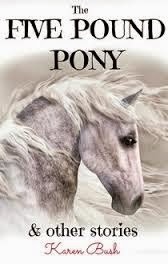 Karen's lovely book
Karen's lovely bookMost people will have heard of the famous Nanowrimo, or National Novel Writing Month, where writers pledge to write a whole novel in the month of November. And the other day, Karen Bush, on Authors Electric wrote about 'Linowrimo' - about how a group of writers, in touch via email, pledge to write a number of words every day, and report on how they got on.
I'm a member of this group too, and, like Karen, find it a constant source of encouragement and help - but it couldn't help me sort out the Bad Girl.
Like many other writers, I've often found that, when I can't write at home, I can write pages and pages in a cafe - or on a CallyMac ferry, or on top of a Scottish mountain, in a Loughborough B&B - in fact, anywhere that's not home.
So I suggested to my friend that we take ourselves off to a pub we both like, and see if we could write there. We agreed that we would buy a drink - rent for our office space - but then write for at least an hour before we talked. My friend agreed. He wasn't sure that it would work, but was so keen to get going on his novel again that it was worth trying.
Dear Readers, it worked. I had thought of taking my laptop, but at the last minute decided to take a pile of scrap paper instead, and a favourite scribbly pen (that is, one that floats easily over the paper.) The more complete a change, the better, I thought - pen and paper in the pub instead of a computer at home.
And even while driving there, it started to work. Why, I wondered, did it have to be that POV? Why not try coming at it through another of the characters?
 A great writing aid.
A great writing aid.We reached the pub and found our table. My friend bought a pint of cider for himself and a half for me, and we started. The moment I sat down, the words came. Within a few moments, I'd largely forgotten where I was, or that my friend was with me. The landlady, at one point, came round to ask if anyone had a silver honda in the car-park. I floated up out of a dream, said, "No, not me," and drifted off into writing-world again.
Every now and again, I'd pause to think of a word, or to take a sip of cider and would think - with mild surprise - 'Oh, yes, that's right, I'm in the pub - and oh, yes, that lowered head and scribbling pen over there, that's my friend...' And then I'd lower my own head and start scribbling again.
I filled page after page - 2000 words. I'm past the part that held me up for so long. Now I'm up against another problem, with another character - but that's okay. Writing a book is just one problem after another.
And my friend? He was very happy with the experiment too. He wrote 882 words - which, he says, is a lot for him at one time. He, too, feels he's made real progress, and asked, "When shall we do it again?" So the landlady may have to get used to two word-dazed people scribbling at her tables.
Why does it work? For me, I think the change is important, though I don't quite understand why. The change of scene, the change from computer to paper - it all seems to shake up my ideas, to loosen or free something.
My friend says that he knew what he had to write, but was procrastinating, feeling that he wasn't quite ready - that he'd think about it some more before beginning. But the days went by and he never did begin. The special outing, and the solemn vow to write for an hour before talking, made him commit to writing then and there, instead of putting it off. The time set, of an hour, made him keep writing, too, when he would normally have stopped.
So, if the writing's not happening - get out of the house!
Published on January 16, 2015 16:00
January 9, 2015
I Talk to Karen King...
Recently my friend, the writer Karen King, interviewed me for her blog.
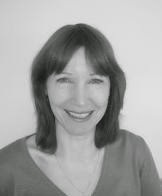 Karen King
Karen King
Karen: What was the first thing you had published?
Sue: The first book I completed: The Devil’s Piper. I wrote it when I was fifteen, typed it on an ancient iron typewriter, and illustrated it myself, in biro pen.(Not a good idea or a success.)
One of A M Heath’s agents, Osyth Leeston, took me on — and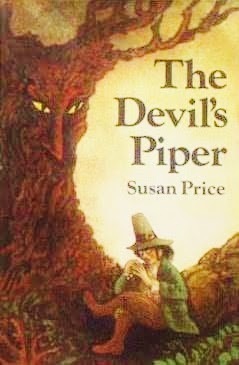 The Devil's Piper by Susan Pricesent the book to Phyllis Hunt, who was then children’s editor for Faber — and a wonderful editor. Phyllis said she would publish the book if I could rewrite it to the standard she required. She sent me a ten page letter of comments on why the book didn’t work as well as it could, and how it could be improved.
The Devil's Piper by Susan Pricesent the book to Phyllis Hunt, who was then children’s editor for Faber — and a wonderful editor. Phyllis said she would publish the book if I could rewrite it to the standard she required. She sent me a ten page letter of comments on why the book didn’t work as well as it could, and how it could be improved.
Looking back at this from over forty years on, I’m incredulous. I don’t think this would happen today. Publishers in those days took more care of their eco-system — they knew they had to be growing authors up to replace those they were going to lose. And, of course, both Osyth and Phyllis were extraordinarily kind and encouraging to me. Phyllis once said that she thought she had ‘brought me up’ as a writer — and I wouldn’t argue with that.
I’ve no doubt there are people just as kind in publishing today, but I don’t think they would have the time or the leeway to help a novice along as I was helped. — Or perhaps I’m completely wrong, and just indulging in a senior moment of ‘things were better in those days?’ If so, please let me know.
Karen: What do you like writing most?

Sue: Something that sells millions, gets turned into a film and makes me rich!
It’s a question I find hard to answer seriously. One of the comments made early in my career by my fairy godmothers, Phyllis and Osyth, was that I wrote a lot of different things, and was hard to categorise. I’ve written ‘kitchen-sink’, historicals, full-on fantasy, folkloric retellings, science-fiction, short stories, ghost stories… I’ve written for pretty much every age-group too, from babies to adults. As you can see, on my Amazon page.
And the book I’m working on now is different again: set in the present day, with a truly evil, heartless main character who enjoys tormenting other people and looks on murder as business.
I enjoy writing it all.
Karen: What piece of writing/work are you most proud of?
Sue: The Ghost World Trilogy, certainly. The first one, The Ghost Drum, won the Carnegie Medal. That was a surprise — but as soon as I finished the book, I knew it was the best thing I’d ever written.
I went on thinking that until I turned all three into e-books (since they’d been allowed to go out of print, and no publisher would reprint them.) This meant scanning them into my computer and re-reading and proofing them all over again. While doing this, I came to the conclusion that the second book, Ghost Song, and the third book, Ghost Dance, were both, in their ways, better than the first.
The books don’t form a classical trilogy, with each book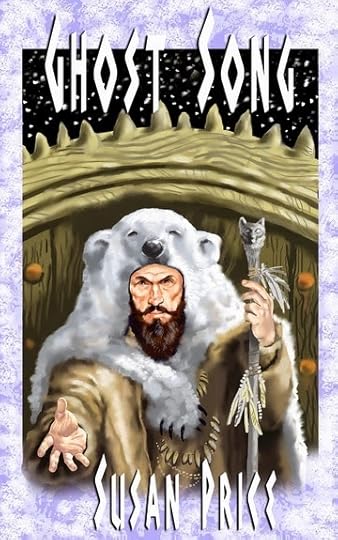 Ghost Song by Susan Pricefollowing on from the one before. In fact, Ghost Song is a prequel to Ghost Drum, and is, I think, more lyrical. Then Ghost Dance is a stand-alone book, though set in the same world. It’s much more sinister than the first two, and has a more complicated plot.
Ghost Song by Susan Pricefollowing on from the one before. In fact, Ghost Song is a prequel to Ghost Drum, and is, I think, more lyrical. Then Ghost Dance is a stand-alone book, though set in the same world. It’s much more sinister than the first two, and has a more complicated plot.
I’ve written a fourth book in the series, Ghost Spell, which I may bring out as an ebook one day.
I recently turned the first two, Drum and Song, into paperbacks, available through Amazon. People who’d read the books when young kept asking me where they could buy paper copies. I’m quite proud that this book is now selling to a second, even third generation!
You can find the e-books here.
And the paperback editions here.
But I’m also quite proud of my Sterkarm books — The Sterkarm Handshake, A Sterkarm Kiss and, soon, I hope, A Sterkarm Embrace. They have probably been the most successful of my books. Recently, I was in a school giving a talk in the library. The talk ended, the class left — but their young teacher doubled back, stuck her head round the door and said, ‘I didn’t realise it was you, but I just want to tell you that when I was 13, Sterkarm Handshake was my favourite book.’
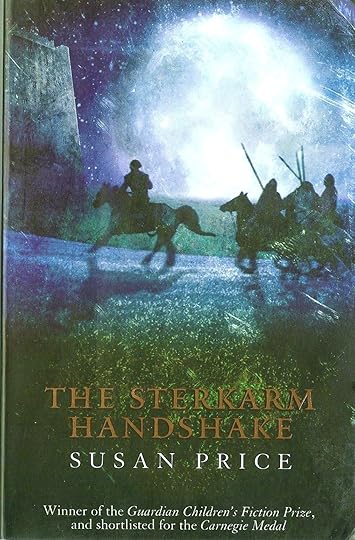 The Sterkarm Handshake by Susan Price Maybe this is why:— Mary Hoffman, the Book Maven, awarded my Sterkarm hero the Number 2 spot in her ‘Ten Hottest Teen Heroes.’
The Sterkarm Handshake by Susan Price Maybe this is why:— Mary Hoffman, the Book Maven, awarded my Sterkarm hero the Number 2 spot in her ‘Ten Hottest Teen Heroes.’
The books are a mixture of science-fiction and history, with the 16th Century Sterkarms clashing violently with the 21st Century time-travelling ‘Elves.’
The Sterkarms are on their third film option at the moment, and I’m just hoping they’ll gallop home with it this time. I’m also hoping that soon I’ll be able to tell people that the first two have been republished, along with the third.
Karen: What’s your favourite poem?
Sue: That’s a tough one. Robert Graves said that you know poetry when you read it because it makes your hair stand on end – and the first time I read Shelley's Ozymandias, I certainly felt my hair rise. I love Marvell’s To His Coy Mistress too — possibly the greatest knicker-dropper of all time!
Despite being an atheist, I love U A Fanthorpe’s religious poems, particularly Joseph. And I’ve loved the old Border Ballads since I was a teenager — all human passion and crime is there: every kind of ‘cide — patri, matri, infanti, fratri. Some wonderful phrases too, as when Edward’s mother asks him what — since he’s determined to ‘set his foot in a bottomless boat’ — does he leave to her? He answers: The World’s room/ To beg your bread/ For all the lies you told to me.’
Karen: What do you like to do to relax?
Sue: Read! — And watch telly. And walk over the hills. I like shooting with my longbow — though only at targets! My partner and I love island-hopping by Cally-Mac ferries. Earlier this year we got up at 3am and drove madly north for 8 hours to catch the noon CallyMac from Oban to Barra in the Outer Hebrides. We’re planning to go to Barra again, but this time make our way up the Hebrides, via ferry and causeway. My partner’s an ex-Met-Office weather observer, and very good at avoiding the worst weather.
Karen: That must come in handy! - What do you like to read?

Sue: All sorts. I loved the Game of Thrones series. I only meant to pass the time by looking into the Amazon sample of A Song Of Ice and Fire, but was hooked and read all seven without a break. Then watched the TV version (very good, but the books were better.)
I love Minette Walters and Sarah Waters. I love legends and mythology. I was stunned by Mantel’s books about Cromwell – so good - and I read and re-read Terry Pratchett all the time.
Thanks for talking, Karen!
Karen's website and blog, where she talks to many other writers, can be found here.
You can read about her activities as Patron of Reading to Edward Oldcorn College in Worcester, all about her books. She offers teaching in Creative Writing too.
 Karen King
Karen King Karen: What was the first thing you had published?
Sue: The first book I completed: The Devil’s Piper. I wrote it when I was fifteen, typed it on an ancient iron typewriter, and illustrated it myself, in biro pen.(Not a good idea or a success.)
One of A M Heath’s agents, Osyth Leeston, took me on — and
 The Devil's Piper by Susan Pricesent the book to Phyllis Hunt, who was then children’s editor for Faber — and a wonderful editor. Phyllis said she would publish the book if I could rewrite it to the standard she required. She sent me a ten page letter of comments on why the book didn’t work as well as it could, and how it could be improved.
The Devil's Piper by Susan Pricesent the book to Phyllis Hunt, who was then children’s editor for Faber — and a wonderful editor. Phyllis said she would publish the book if I could rewrite it to the standard she required. She sent me a ten page letter of comments on why the book didn’t work as well as it could, and how it could be improved.Looking back at this from over forty years on, I’m incredulous. I don’t think this would happen today. Publishers in those days took more care of their eco-system — they knew they had to be growing authors up to replace those they were going to lose. And, of course, both Osyth and Phyllis were extraordinarily kind and encouraging to me. Phyllis once said that she thought she had ‘brought me up’ as a writer — and I wouldn’t argue with that.
I’ve no doubt there are people just as kind in publishing today, but I don’t think they would have the time or the leeway to help a novice along as I was helped. — Or perhaps I’m completely wrong, and just indulging in a senior moment of ‘things were better in those days?’ If so, please let me know.
Karen: What do you like writing most?

Sue: Something that sells millions, gets turned into a film and makes me rich!
It’s a question I find hard to answer seriously. One of the comments made early in my career by my fairy godmothers, Phyllis and Osyth, was that I wrote a lot of different things, and was hard to categorise. I’ve written ‘kitchen-sink’, historicals, full-on fantasy, folkloric retellings, science-fiction, short stories, ghost stories… I’ve written for pretty much every age-group too, from babies to adults. As you can see, on my Amazon page.
And the book I’m working on now is different again: set in the present day, with a truly evil, heartless main character who enjoys tormenting other people and looks on murder as business.
I enjoy writing it all.
Karen: What piece of writing/work are you most proud of?
Sue: The Ghost World Trilogy, certainly. The first one, The Ghost Drum, won the Carnegie Medal. That was a surprise — but as soon as I finished the book, I knew it was the best thing I’d ever written.
I went on thinking that until I turned all three into e-books (since they’d been allowed to go out of print, and no publisher would reprint them.) This meant scanning them into my computer and re-reading and proofing them all over again. While doing this, I came to the conclusion that the second book, Ghost Song, and the third book, Ghost Dance, were both, in their ways, better than the first.
The books don’t form a classical trilogy, with each book
 Ghost Song by Susan Pricefollowing on from the one before. In fact, Ghost Song is a prequel to Ghost Drum, and is, I think, more lyrical. Then Ghost Dance is a stand-alone book, though set in the same world. It’s much more sinister than the first two, and has a more complicated plot.
Ghost Song by Susan Pricefollowing on from the one before. In fact, Ghost Song is a prequel to Ghost Drum, and is, I think, more lyrical. Then Ghost Dance is a stand-alone book, though set in the same world. It’s much more sinister than the first two, and has a more complicated plot. I’ve written a fourth book in the series, Ghost Spell, which I may bring out as an ebook one day.
I recently turned the first two, Drum and Song, into paperbacks, available through Amazon. People who’d read the books when young kept asking me where they could buy paper copies. I’m quite proud that this book is now selling to a second, even third generation!
You can find the e-books here.
And the paperback editions here.
But I’m also quite proud of my Sterkarm books — The Sterkarm Handshake, A Sterkarm Kiss and, soon, I hope, A Sterkarm Embrace. They have probably been the most successful of my books. Recently, I was in a school giving a talk in the library. The talk ended, the class left — but their young teacher doubled back, stuck her head round the door and said, ‘I didn’t realise it was you, but I just want to tell you that when I was 13, Sterkarm Handshake was my favourite book.’
 The Sterkarm Handshake by Susan Price Maybe this is why:— Mary Hoffman, the Book Maven, awarded my Sterkarm hero the Number 2 spot in her ‘Ten Hottest Teen Heroes.’
The Sterkarm Handshake by Susan Price Maybe this is why:— Mary Hoffman, the Book Maven, awarded my Sterkarm hero the Number 2 spot in her ‘Ten Hottest Teen Heroes.’ Per Sterkarm in The Sterkarm Handshake by Susan Price. It’s pronounced “stark-arm” and is the name of a family of 16th century border bandits. Per is the only and most beloved son, whose pretty face gets him the nickname of “the May” or maid. But he’s a useful man in a battle, a lusty lover and one who inspires devotion in everyone from his father, to his hounds, to the 21st century time-traveller Andrea.
The books are a mixture of science-fiction and history, with the 16th Century Sterkarms clashing violently with the 21st Century time-travelling ‘Elves.’
The Sterkarms are on their third film option at the moment, and I’m just hoping they’ll gallop home with it this time. I’m also hoping that soon I’ll be able to tell people that the first two have been republished, along with the third.
Karen: What’s your favourite poem?
Sue: That’s a tough one. Robert Graves said that you know poetry when you read it because it makes your hair stand on end – and the first time I read Shelley's Ozymandias, I certainly felt my hair rise. I love Marvell’s To His Coy Mistress too — possibly the greatest knicker-dropper of all time!
Despite being an atheist, I love U A Fanthorpe’s religious poems, particularly Joseph. And I’ve loved the old Border Ballads since I was a teenager — all human passion and crime is there: every kind of ‘cide — patri, matri, infanti, fratri. Some wonderful phrases too, as when Edward’s mother asks him what — since he’s determined to ‘set his foot in a bottomless boat’ — does he leave to her? He answers: The World’s room/ To beg your bread/ For all the lies you told to me.’
Karen: What do you like to do to relax?
Sue: Read! — And watch telly. And walk over the hills. I like shooting with my longbow — though only at targets! My partner and I love island-hopping by Cally-Mac ferries. Earlier this year we got up at 3am and drove madly north for 8 hours to catch the noon CallyMac from Oban to Barra in the Outer Hebrides. We’re planning to go to Barra again, but this time make our way up the Hebrides, via ferry and causeway. My partner’s an ex-Met-Office weather observer, and very good at avoiding the worst weather.
Karen: That must come in handy! - What do you like to read?

Sue: All sorts. I loved the Game of Thrones series. I only meant to pass the time by looking into the Amazon sample of A Song Of Ice and Fire, but was hooked and read all seven without a break. Then watched the TV version (very good, but the books were better.)
I love Minette Walters and Sarah Waters. I love legends and mythology. I was stunned by Mantel’s books about Cromwell – so good - and I read and re-read Terry Pratchett all the time.
Thanks for talking, Karen!
Karen's website and blog, where she talks to many other writers, can be found here.
You can read about her activities as Patron of Reading to Edward Oldcorn College in Worcester, all about her books. She offers teaching in Creative Writing too.
Published on January 09, 2015 16:00
January 2, 2015
'Her Lines, My Lines' - a review
My friend, Joan Lennon, has many talents - as you can discover
 Author Joan Lennon here, on her website.
Author Joan Lennon here, on her website.
Having the sense to live in Scotland is one talent. Being quick and witty is another.
I've admired her poems for a long time. Like Joan's photos, they often focus on a vivid detail, which might go overlooked by others. They make us look again, and see.
Her Lines, My Lines has poems by Joan, and illustrations by Kyla Tomlinson. It came out of a six-month Writer-in-Residence post, based in Blairgowrie, funded by Creative Scotland. They do better by their writers in Scotland.
There are so many poems in this book I would like to bring to your attention, but there are only 14 in the book, and I'd end up putting the whole lot into this post - which would not be right. But I can give you a taster...
She said, "They're not your boys - they're grown men."
...When I am rich soilAnd quieted by time,I will shift and stir,restless still in rhythmWith your sleeplessness.
One long sequence of poems is The Week It Snowed. Joan captures the changing light and colour of snow and the north:
in the evening,periwinkle (prussian in the shadows)fades through glaucousinto slate.
 She sees Lichen on a Gravestone.
She sees Lichen on a Gravestone.
...in ruckled puffslike tangible sky breath -slow fireworks...
I am butchering these poems because I don't want to be guilty of giving away someone else's work for free - but they deserve to be read in full. Again and again a few words, a phrase, captures and fills my head with an image or sensation.
The book can be bought here - http://www.bookmarkblair.com/shop.php
Joan's other books for children and adults are worth checking out too. You can find them here.
 Author Joan Lennon here, on her website.
Author Joan Lennon here, on her website.Having the sense to live in Scotland is one talent. Being quick and witty is another.
I've admired her poems for a long time. Like Joan's photos, they often focus on a vivid detail, which might go overlooked by others. They make us look again, and see.
Her Lines, My Lines has poems by Joan, and illustrations by Kyla Tomlinson. It came out of a six-month Writer-in-Residence post, based in Blairgowrie, funded by Creative Scotland. They do better by their writers in Scotland.
There are so many poems in this book I would like to bring to your attention, but there are only 14 in the book, and I'd end up putting the whole lot into this post - which would not be right. But I can give you a taster...
She said, "They're not your boys - they're grown men."
...When I am rich soilAnd quieted by time,I will shift and stir,restless still in rhythmWith your sleeplessness.
One long sequence of poems is The Week It Snowed. Joan captures the changing light and colour of snow and the north:
in the evening,periwinkle (prussian in the shadows)fades through glaucousinto slate.
 She sees Lichen on a Gravestone.
She sees Lichen on a Gravestone....in ruckled puffslike tangible sky breath -slow fireworks...
I am butchering these poems because I don't want to be guilty of giving away someone else's work for free - but they deserve to be read in full. Again and again a few words, a phrase, captures and fills my head with an image or sensation.
The book can be bought here - http://www.bookmarkblair.com/shop.php
Joan's other books for children and adults are worth checking out too. You can find them here.
Published on January 02, 2015 16:00
December 19, 2014
Make room for Imps! - A Guest Post by Simon Hanley
I'm giving the blog over to a guest this week. Here, the artist Simon Hanley talks about designing a character and his ImpLounge project.
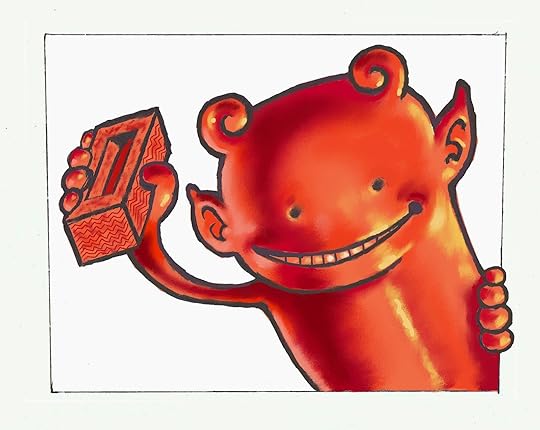 Hi, I'm a bright red brick chucking imp - pleased to meet 'cha!Sometime ago after stumbling on the Print On Demand site Zazzle, and determining to have a go at selling at least one item on it – I was looking around for an idea, a theme I suppose, and I hit on devils.
Hi, I'm a bright red brick chucking imp - pleased to meet 'cha!Sometime ago after stumbling on the Print On Demand site Zazzle, and determining to have a go at selling at least one item on it – I was looking around for an idea, a theme I suppose, and I hit on devils.
I don’t know why I felt I needed a theme; possibly it was so I wouldn’t lose interest. After a while I downgraded the idea to imps. Not quite as nasty as devils, less sickly sweet than fairies and elves.
Then doodling, I came up with this image, and I gave it the temporary title ‘Brick Chucking Devil.’ I liked him, he seemed to have a bit of character, was bold and therefore noticeable – in fact he was impish and my idea for a theme began to grow. This sketch, even though I liked it was still just a sketch, done in pencil on paper and then scanned and quickly coloured. I felt it would look better after I had drawn a proper clean outline using a graphic tablet. I like the strong clean outline, with a big vibrant colour. With different designs maybe a subject might benefit from some patterning in the way of stripes or spots to give it some life and you have something that can be seen across a room.
This simple imp was the first thing I designed for my project, and I have used the same approach to design a handful of others just like him. They’re all rendered with a rounded realistic feel, with strong light sources hitting them at the side. I like a good strong yellow for the one side with the opposite side illuminated by a blue. The light should zing and sparkle and give a slick glossy effect.
Here’s the latest addition to the small red imp family, looking highly pleased with himself. Note the light effects on the teeth, I tried to give an appearance of them glittering in a burst of light, like a flash photograph. I suppose that’s the look I’m going for, the celebrity imp caught in the flashlights glare.
 This bright red Imp used 'Vrill' toothpaste!
This bright red Imp used 'Vrill' toothpaste!
To achieve the effect is easy enough: use an art package that has layers - Corel Draw, Photoshop, Painter - and draw a thick black outline on a floating layer. Then place colour underneath on another layer. You might prefer to scan a drawing, and then have that also on a separate layer, with the opacity reduced. This helps to guide your hand while redrawing it, without tending to compel you to follow the original drawing. It’s always best to be a little flexible, and you might want to make changes to the redrawing as you go along. The thing we need is boldness, and a simple approach that can be used quickly and even adapted to use again for other similar designs.
For an idea of how the different stages look, here’s an image of just the outline of the finished design Although it looks similar to the pencil sketch it isn't traced, just drawn using a bamboo tablet using the original for reference.
 I may be smiling - but actually I'm feeling a little drained.
I may be smiling - but actually I'm feeling a little drained.
And here's a look at the finished article, after a coloured layer is placed beneath the lines.
 Ah, that's better.
Ah, that's better.
The original drawing at the top of the page and this one do look very similar, the greatest change being the size of the eyes. In the original I made them quite small, but found the 'cuteness' quota was improved by enlarging the eyes. The tiny eyes I originally gave him made him look insane or stupid, which wasn't the path I wanted to take.
Finally I’m well aware that some people don’t like any talk about devils, imps and so forth, but it’s a big world wide web, and those people will either have to indulge me or go to a less devilish corner of places www. If you’re still with me, why not check out my website, at the Implounge?




http://implounge.jimdo.com/
https://www.flickr.com/photos/128857877@N07/
 Hi, I'm a bright red brick chucking imp - pleased to meet 'cha!Sometime ago after stumbling on the Print On Demand site Zazzle, and determining to have a go at selling at least one item on it – I was looking around for an idea, a theme I suppose, and I hit on devils.
Hi, I'm a bright red brick chucking imp - pleased to meet 'cha!Sometime ago after stumbling on the Print On Demand site Zazzle, and determining to have a go at selling at least one item on it – I was looking around for an idea, a theme I suppose, and I hit on devils.I don’t know why I felt I needed a theme; possibly it was so I wouldn’t lose interest. After a while I downgraded the idea to imps. Not quite as nasty as devils, less sickly sweet than fairies and elves.
Then doodling, I came up with this image, and I gave it the temporary title ‘Brick Chucking Devil.’ I liked him, he seemed to have a bit of character, was bold and therefore noticeable – in fact he was impish and my idea for a theme began to grow. This sketch, even though I liked it was still just a sketch, done in pencil on paper and then scanned and quickly coloured. I felt it would look better after I had drawn a proper clean outline using a graphic tablet. I like the strong clean outline, with a big vibrant colour. With different designs maybe a subject might benefit from some patterning in the way of stripes or spots to give it some life and you have something that can be seen across a room.
This simple imp was the first thing I designed for my project, and I have used the same approach to design a handful of others just like him. They’re all rendered with a rounded realistic feel, with strong light sources hitting them at the side. I like a good strong yellow for the one side with the opposite side illuminated by a blue. The light should zing and sparkle and give a slick glossy effect.
Here’s the latest addition to the small red imp family, looking highly pleased with himself. Note the light effects on the teeth, I tried to give an appearance of them glittering in a burst of light, like a flash photograph. I suppose that’s the look I’m going for, the celebrity imp caught in the flashlights glare.
 This bright red Imp used 'Vrill' toothpaste!
This bright red Imp used 'Vrill' toothpaste!To achieve the effect is easy enough: use an art package that has layers - Corel Draw, Photoshop, Painter - and draw a thick black outline on a floating layer. Then place colour underneath on another layer. You might prefer to scan a drawing, and then have that also on a separate layer, with the opacity reduced. This helps to guide your hand while redrawing it, without tending to compel you to follow the original drawing. It’s always best to be a little flexible, and you might want to make changes to the redrawing as you go along. The thing we need is boldness, and a simple approach that can be used quickly and even adapted to use again for other similar designs.
For an idea of how the different stages look, here’s an image of just the outline of the finished design Although it looks similar to the pencil sketch it isn't traced, just drawn using a bamboo tablet using the original for reference.
 I may be smiling - but actually I'm feeling a little drained.
I may be smiling - but actually I'm feeling a little drained.And here's a look at the finished article, after a coloured layer is placed beneath the lines.
 Ah, that's better.
Ah, that's better.The original drawing at the top of the page and this one do look very similar, the greatest change being the size of the eyes. In the original I made them quite small, but found the 'cuteness' quota was improved by enlarging the eyes. The tiny eyes I originally gave him made him look insane or stupid, which wasn't the path I wanted to take.
Finally I’m well aware that some people don’t like any talk about devils, imps and so forth, but it’s a big world wide web, and those people will either have to indulge me or go to a less devilish corner of places www. If you’re still with me, why not check out my website, at the Implounge?




http://implounge.jimdo.com/
https://www.flickr.com/photos/128857877@N07/
Published on December 19, 2014 16:00
December 5, 2014
Very Far From Where You Are Now...
 The mountain...
The mountain...Far, very far, from where you are now, there stands a mountain at the end of the earth.
The mountain is three miles high, three miles wide and three miles deep.
It is made all of adamantine diamond, the hardest thing that is.
Once, and once only in every thousand years, there comes to the diamond mountain a little bird, a tiny bird, a bird no bigger than the fingernail on your littlest finger.
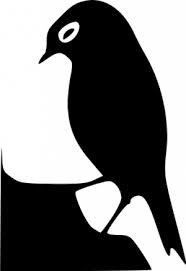 A tiny bird...
A tiny bird...The tiny bird, once in every thousand years, lights on the diamond mountain and sharpens its beak with three strops - One! Two! Three!
And when this tiny bird, which is no bigger than the nail on your littlest finger, and which comes to the mountain only once in every thousand years, when this little bird, with sharpening of its beak, has ground the diamond mountain, which is three miles high, three miles wide, and three miles deep...
When, with three strokes of its tiny bill, once in every thousand years, this little bird has ground the adamantine mountain all, all away...
Has ground it to the finest, finest dust...
And when the last grain of diamond dust has blown away on the wind, and there is not one grain left of the mountain...
Then, and only then, will be ended the first eye-blink of Eternity.
 Eternity
EternityI've known this for ages, but remembered it the other night when we were in a folk club. I thought it was a suitably fairy-tale, Christmassy thing to post at this time of year.
It's a fragment from the Brothers Grimm - though this is my version, retold from memory and no doubt changed.
Published on December 05, 2014 16:00
November 21, 2014
Gigging
 After finishing the training with the Royal Literary Fund, I thought life would be quieter, and I'd be back to posting a blog here every Saturday. Ha!
After finishing the training with the Royal Literary Fund, I thought life would be quieter, and I'd be back to posting a blog here every Saturday. Ha!Since the RLF had invested all that time and money in me, I couldn't let it go to waste, y'know. And I needed to earn some more money.
Up until this year, I'd always let work come to me. I'm listed on Contactanauthor and various county library lists as an author who does school visits. I didn't do as many school visits as some of my friends, but I did quite a few - but the number has been falling off..
It was time, I decided, to be pro-active.
I was raised on the principle that you never pay for anything if there's any way you can bodge up the old item, make a new one yourself or do without it. So it took some grtting of the teeth, and long thought, to actually pay for an advertising campaign to be sent into schools. I made up my mind to do it, though. I reasoned that two gigs would pay for it, and I thought I could manage that. So at worst, I would break even and not lose anything.
I used the excellent company, Sprint Education, who not only have their own data-base of thousands of teachers, but also give a lot of free advice on how to improve your ad.
 The Sprint Education brothers
The Sprint Education brothersMy emails went out at 9am on 11th September, and I had my first phone-call from a school at 12-10 pm the same day.
After that I answered emails and phone-calls solidly for a week. Things slowed down a little after that, but enquiries continued to come in - and they still are coming in, two months later. I have three times the work booked that I did last year.
But preparing all these talks and workshops, with powerpoint slides and hand-outs - and making the travel plans, and booking overnight accommodation and packing everything that's needed, and checking and re-checking - all takes a lot of time. So I haven't been getting much else done. And forget housework. If you visit me, you wipe your feet on the way out. Burglars break in and tidy up.
Still, it's all energising and great fun. I think the highlight of the gig I did this week was working with the Primary School class that was brought into the Secondary school. They were only nine, and over-awed by being at the Big School. They crept nervously into the library, staying close to their teachers, almost afraid to look at anything.
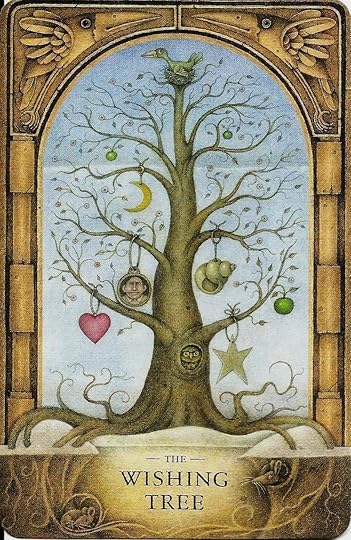 From StoryWorld CardsI used the wonderful StoryWorld cards with them. First I gave them each a character card, and asked them to come up with everything they could about those characters. The cards are beautiful and packed with detail. In moments, the children were completely different - bright-eyed and smiling, all eager to tell me and their teachers what they'd 'found out' about their character.
From StoryWorld CardsI used the wonderful StoryWorld cards with them. First I gave them each a character card, and asked them to come up with everything they could about those characters. The cards are beautiful and packed with detail. In moments, the children were completely different - bright-eyed and smiling, all eager to tell me and their teachers what they'd 'found out' about their character.Next, I gave out 'place' or 'object' cards - The Castle, The Key, The River - and asked them to find the connection between that card and their character. In the next round, I gave out animal cards. By this time, they were having such a great time, they'd completely forgotten to be shy. It was wonderful to hear how they took the tiniest clue and - I was going to say 'ran with it' but I think 'danced with it' would be more accurate.
The Princess was named 'Daisy' because of the flowers on her dress, and she was presently going to be leaving in the hot-air balloon to be seen in the distance. The cosy looking mother, stirring cake mix in a bowl, happened to be drawn with the Wishing Tree (above) by one group. They decided that she was secretly a witch, and that her wishing tree was hung with spells and curses - but that the bird at the top was going to destroy her by splashing her with water.
Another group drew The Soldier, and invented his wandering by carefully examining the landscape behind him. The cat in the picture was his friend and told him of a princess who needed rescuing - but when they reached the tower, the princess wasn't there. They happened to draw the 'Door into Faeryland' card, and so their soldier made tracks in that direction, only to be brought up short by the guardian trees one either side of the gate... But the eyes looking out from under the tree roots belong to the friendly cat, who is going to help him...
One of the teachers said, "These cards are amazing." So I gave her the details of their online site - and I pass on the details here, in time for Christmas. (They're available, here, from Amazon too. I gave a set, last year, to an infant of my acquaintance, and have heard excellent reports of them.)
StoryWorld
Anyhow, in short, this is why I can't find time to blog reguarly. I have two more gigs coming up in December, and after that, it's all quiet for a bit until February. Book Week in March is going to be fairly frantic - and there's an RLF reunion that month as well. It's all hard work, but good fun - and paid too!
Published on November 21, 2014 16:00
October 31, 2014
Ninja Driving and other things
A friend asked me, a while ago, how the ninja driving was going.
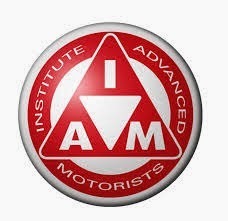 Institute of Advanced Motorists
Institute of Advanced Motorists
Well, it's still going. Which is a bit vexing. I feel I should have passed by now.
My driving has improved enormously. I've reached that stage where I look back at how my driving was, a bit over a year ago, and feel embarrassed that it was so bad when I thought it was okay.
I never went so far as to think that I was a good driver - but I thought I was sort of average. As Flann O'Brien would have put it, I felt that 'of all the nincompoops in the world, I was not the worst.' When it came to driving, anyway.
Now I look back and think, well, actually, I was pretty bad. Inattentive. Careless. Hard on the brakes because I hadn't seen the need to brake until the last moment. Giving confusing signals. A bit hazy on road-signs, and therefore not picking up all the information and warnings that I could have done. And not taking in most of the information from the signs I did notice.
Quick now: What shape is a Give Way sign?
I had to attend a 'Speed Awareness' class the other day too, because I got caught speeding in a 30 zone. This was embarrassing, not just because I'm training to be an advanced driver, but because, at the time I was caught, I was actually trying hard to observe all the rules of the road, because I'm hoping to be given the go-ahead to take the advanced test soon.
I was driving from home in the West Midlands to Cardiff, and spent most of the journey at high speeds on motorways. Leaving the motorway on the outskirts of Cardiff, I slowed right down to something that seemed ridiculously slow.
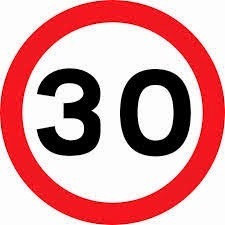 After the motorway, 30 always feels like you could crawl faster on your hands and knees. But I was trying to keep to 30, because I was treating the trip as a practice run. Still, I wasn't watching the speedo closely enough because - Flash! They got me.
After the motorway, 30 always feels like you could crawl faster on your hands and knees. But I was trying to keep to 30, because I was treating the trip as a practice run. Still, I wasn't watching the speedo closely enough because - Flash! They got me.
Not that I'm making any excuses. Speed limits are there to reduce accidents and save lives. I broke the law, simple as that. I was grateful to be given the chance to take a Speed Awareness Class instead of getting points on my license and a hike in insurance.
The Class was much more entertaining than I expected it to be, and really rather useful. It was presented by an ex-policeman - and he looked it. Tall, broad, straight, official hair-cut - you'd have spotted him as an ex-rozzer from the other end of the street.
(I've just had to stop to look up that interesting word, 'rozzer.' - 'Slang, 19th Century, origin unknown.')
He gave very good workshop, though. In fact, I was taking notes on his workshop technique as much as becoming speed aware.
The point about speed and safety was driven home, as by a sledgehammer. What's the speed limit in the street where you live? Do you agree with it being set at that? - Those who lived in streets with a 20 or 30 limit readily agreed with him that it meant their families were safer.
There were a few who lived on streets with a 40 limit, and he drew from them an agreement that it would be safer for them and their family if the limit was lower.
So why, he asked them, were you speeding in other people's
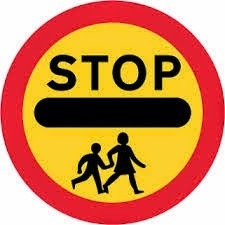 streets? Don't the people who live there have families?
streets? Don't the people who live there have families?
Ignorance and carelessness were no excuse. If a driver killed or injured one of your family members, would you be happy if their excuse was, 'I didn't know it was a 30,' or, 'I hadn't noticed I was doing 40?'
Of course, no one could honestly say that.
The instructor showed us graphs and statistics, which demonstrated how rapidly the likelihood of death rises, in the pedestrian/vehicle interface, above the speed of 30. It's a steep curve. Even a mile or two an hour extra means far more severe injuries, and far worse 'insults' to the brain when the car-flung person hits the tarmac with their head.
He invited us to contemplate our car hitting 'little Mary' who has run out unexpectedly from behind parked cars. We were asked to imagine a car travelling at 40 striking her with its bumper, and the injuries that would cause... Her being tossed up onto the bonnet and smashing the windscreen... And then either being flung to one side, to scrape her flesh across the road surface, or being catapulted over the roof and flung several feet down the road, landing on her head.
What was the likelihood of her surviving? We looked at the graph. They weren't high.

What excuse were we going to make to her parents? 'I was in a hurry.' - 'I didn't know it was a 30.' - 'I didn't know I was doing 30.'
The class proved useful for Advanced Driving training, as we were taught a 'fool-proof' way to recognise a 30 mile an hour area. It's also sharpened up my ability to spot those speed signs.
So where am I with the ninja driving? Well, my ever-patient ex-paramedic mentor says, "There's been immense improvement, Sue. We'll have another couple of run-rounds, and then I'll see about arranging another pre-test." - Because the IAM won't put you in for the real test until they're certain you can pass it.
This will be my third pre-test, which I don't feel is a good sign. The problem is, as soon as it's a test - even if only a mock-one - all my certainty deserts me and I start questioning my every decision - and usually making the wrong choice.
The secret is to cultivate an, 'I don't give a damn,' attitude and just drive. Then I'd probably pass, The difficulty with that is, I would rather like to pass, so I do give a bit of a damn, and it's that that gets in the way.
What shape is a Give Way sign? - It's the only sign on the British road that's shaped like an inverted triangle. All other warning or advisory signs are upright triangles, with the single point at the top.
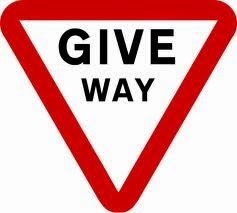
And the fool-proof way of recognising a 30 limit? - If you're a better driver than me, you probably already know.
If there's a lighting-system installed on the street - that is, three or more lamposts - and no other speed signs at all - then it's a 30. No ifs, buts or question.
Doesn't matter if it's a broad, inviting road with open country on one side, or few houses... If there is a lighting-system and no other speed sign, then it's a 30. If it's a 20, or above, there will be a big 'gateway' sign to tell you, and small repeaters. If there's none of them - it's a 30. I feel much happier now I've grasped this.
I also came away with permission from the ex-rozzer to drive in third-gear in a 30 mile limit - it's the only way to drive a modern car at 30, he said. A conclusion I had already come to - but I keep having to argue it with my IAM mentors, as they insist on saving petrol by 'driving in the highest gear conditions allow.' I can now insist on 3rd at 30, and quote an ex-rozzer at them.
 Institute of Advanced Motorists
Institute of Advanced MotoristsWell, it's still going. Which is a bit vexing. I feel I should have passed by now.
My driving has improved enormously. I've reached that stage where I look back at how my driving was, a bit over a year ago, and feel embarrassed that it was so bad when I thought it was okay.
I never went so far as to think that I was a good driver - but I thought I was sort of average. As Flann O'Brien would have put it, I felt that 'of all the nincompoops in the world, I was not the worst.' When it came to driving, anyway.
Now I look back and think, well, actually, I was pretty bad. Inattentive. Careless. Hard on the brakes because I hadn't seen the need to brake until the last moment. Giving confusing signals. A bit hazy on road-signs, and therefore not picking up all the information and warnings that I could have done. And not taking in most of the information from the signs I did notice.
Quick now: What shape is a Give Way sign?
I had to attend a 'Speed Awareness' class the other day too, because I got caught speeding in a 30 zone. This was embarrassing, not just because I'm training to be an advanced driver, but because, at the time I was caught, I was actually trying hard to observe all the rules of the road, because I'm hoping to be given the go-ahead to take the advanced test soon.
I was driving from home in the West Midlands to Cardiff, and spent most of the journey at high speeds on motorways. Leaving the motorway on the outskirts of Cardiff, I slowed right down to something that seemed ridiculously slow.
 After the motorway, 30 always feels like you could crawl faster on your hands and knees. But I was trying to keep to 30, because I was treating the trip as a practice run. Still, I wasn't watching the speedo closely enough because - Flash! They got me.
After the motorway, 30 always feels like you could crawl faster on your hands and knees. But I was trying to keep to 30, because I was treating the trip as a practice run. Still, I wasn't watching the speedo closely enough because - Flash! They got me.Not that I'm making any excuses. Speed limits are there to reduce accidents and save lives. I broke the law, simple as that. I was grateful to be given the chance to take a Speed Awareness Class instead of getting points on my license and a hike in insurance.
The Class was much more entertaining than I expected it to be, and really rather useful. It was presented by an ex-policeman - and he looked it. Tall, broad, straight, official hair-cut - you'd have spotted him as an ex-rozzer from the other end of the street.
(I've just had to stop to look up that interesting word, 'rozzer.' - 'Slang, 19th Century, origin unknown.')
He gave very good workshop, though. In fact, I was taking notes on his workshop technique as much as becoming speed aware.
The point about speed and safety was driven home, as by a sledgehammer. What's the speed limit in the street where you live? Do you agree with it being set at that? - Those who lived in streets with a 20 or 30 limit readily agreed with him that it meant their families were safer.
There were a few who lived on streets with a 40 limit, and he drew from them an agreement that it would be safer for them and their family if the limit was lower.
So why, he asked them, were you speeding in other people's
 streets? Don't the people who live there have families?
streets? Don't the people who live there have families?Ignorance and carelessness were no excuse. If a driver killed or injured one of your family members, would you be happy if their excuse was, 'I didn't know it was a 30,' or, 'I hadn't noticed I was doing 40?'
Of course, no one could honestly say that.
The instructor showed us graphs and statistics, which demonstrated how rapidly the likelihood of death rises, in the pedestrian/vehicle interface, above the speed of 30. It's a steep curve. Even a mile or two an hour extra means far more severe injuries, and far worse 'insults' to the brain when the car-flung person hits the tarmac with their head.
He invited us to contemplate our car hitting 'little Mary' who has run out unexpectedly from behind parked cars. We were asked to imagine a car travelling at 40 striking her with its bumper, and the injuries that would cause... Her being tossed up onto the bonnet and smashing the windscreen... And then either being flung to one side, to scrape her flesh across the road surface, or being catapulted over the roof and flung several feet down the road, landing on her head.
What was the likelihood of her surviving? We looked at the graph. They weren't high.

What excuse were we going to make to her parents? 'I was in a hurry.' - 'I didn't know it was a 30.' - 'I didn't know I was doing 30.'
The class proved useful for Advanced Driving training, as we were taught a 'fool-proof' way to recognise a 30 mile an hour area. It's also sharpened up my ability to spot those speed signs.
So where am I with the ninja driving? Well, my ever-patient ex-paramedic mentor says, "There's been immense improvement, Sue. We'll have another couple of run-rounds, and then I'll see about arranging another pre-test." - Because the IAM won't put you in for the real test until they're certain you can pass it.
This will be my third pre-test, which I don't feel is a good sign. The problem is, as soon as it's a test - even if only a mock-one - all my certainty deserts me and I start questioning my every decision - and usually making the wrong choice.
The secret is to cultivate an, 'I don't give a damn,' attitude and just drive. Then I'd probably pass, The difficulty with that is, I would rather like to pass, so I do give a bit of a damn, and it's that that gets in the way.
What shape is a Give Way sign? - It's the only sign on the British road that's shaped like an inverted triangle. All other warning or advisory signs are upright triangles, with the single point at the top.

And the fool-proof way of recognising a 30 limit? - If you're a better driver than me, you probably already know.
If there's a lighting-system installed on the street - that is, three or more lamposts - and no other speed signs at all - then it's a 30. No ifs, buts or question.
Doesn't matter if it's a broad, inviting road with open country on one side, or few houses... If there is a lighting-system and no other speed sign, then it's a 30. If it's a 20, or above, there will be a big 'gateway' sign to tell you, and small repeaters. If there's none of them - it's a 30. I feel much happier now I've grasped this.
I also came away with permission from the ex-rozzer to drive in third-gear in a 30 mile limit - it's the only way to drive a modern car at 30, he said. A conclusion I had already come to - but I keep having to argue it with my IAM mentors, as they insist on saving petrol by 'driving in the highest gear conditions allow.' I can now insist on 3rd at 30, and quote an ex-rozzer at them.
Published on October 31, 2014 17:00
October 24, 2014
Ghostly Music for Hallowe'en
It's Hallowe'en this coming Friday, but as I usually post on
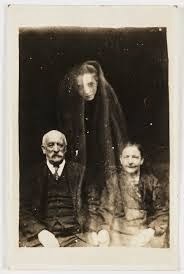 A 'Spirit Photo': public domainSaturday, I shall miss it. And it's no use posting about Hallowe'en on Saturday, November 1, as that is, of course, All Souls Day, when the bogies and boggarts are all banished away - until sometime around Christmas, when they seem to come back, in time for our tradition of telling Christmas ghost stories.
A 'Spirit Photo': public domainSaturday, I shall miss it. And it's no use posting about Hallowe'en on Saturday, November 1, as that is, of course, All Souls Day, when the bogies and boggarts are all banished away - until sometime around Christmas, when they seem to come back, in time for our tradition of telling Christmas ghost stories.
All fine by me, as I'm always ready to tell ghost stories.
I think I've blogged before about my family's stalwart efforts to remain sceptical and hard-headed despite all the yammering from the other world.
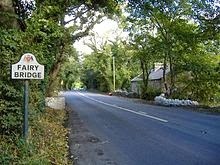 Wikipedia: The Fairy Bridge
Wikipedia: The Fairy Bridge
There's my cousin, for instance, Alan Hess. Studied chemistry, worked in the computer industry and is a man of science. When he lived on the Isle of Man, and was told that, when crossing the Fairy Bridge, you always have to politely wish 'good morning,' to the fairies - or ill-luck will befall you.
Naturally, being a man of science, he scoffed. And the next time he drove across the Fairy Bridge, he called out - well, this is a family-friendly blog, so I won't say what he called out. But he was dreadfully rude to the fairies.
And lost control of the car, skidded across the road and ended up in the ditch. After that, he was always very polite to the fairies. But ask him about it now, and he maintains that it was coincidence. Pure coincidence.
But my main tale today is unseasonal. Davy and I once went for a walk along the river Teem. It was August, and about as hot as August can be. We walked through pasture and cornfields, climbing stiles and crossing bridges over small streams. It was beautiful, but we became very thirsty.
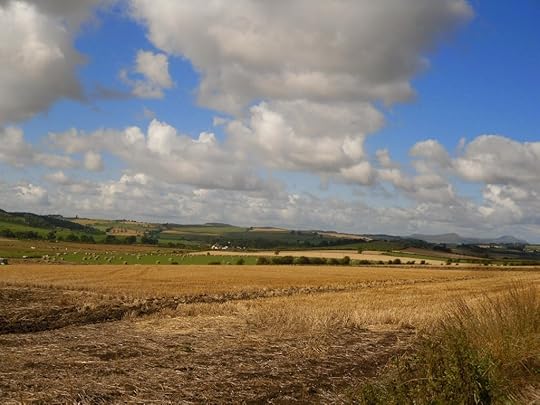
It was a long trek back to the pub where we'd left the car, but I saw a church spire rising over the tree-tops. The church was much nearer. "Where's there's a church, there's probably a village," I said. "Maybe a pub - or a least a shop where we could buy a bottle of water."
So we walked on, and came to a wooden bridge that would take us across the river to the church. The banks were thickly wooded, so we couldn't see anything of the church, or any neighbouring buildings, except the spire.
Once over the bridge, we came on an oddly desolate scene. There was no village - or any other building at all except the church.
But there had been a village. We could see the raised, roughly square and oblong platforms where the buildings had stood. You could see the streets that ran between them. Sheep wandered here and there, walking the sunken streets and clambering over what had been houses.
We wandered around the church, noting the changes to it, the walled up doors and windows. Davy said he'd like to see inside, so we went around to the porch.
I was struggling with the big iron door handle when Davy said, "Don't!" I looked over my shoulder at him, a bit puzzled. "There's a service going on," he said.
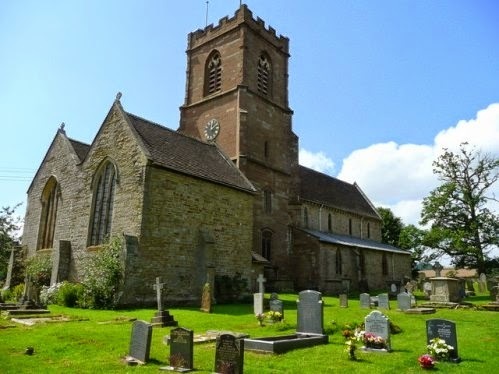
I was even more puzzled. I didn't think my hearing was that bad. I hadn't, and couldn't, hear anything except the sheep and the river. I put my head close to the door and listened. I could hear nothing from inside the church.
"No, there's not," I said, and tried again to open the door.
"There's somebody practicing on the organ then," Davy said. "We shouldn't disturb them."
I gave him a funny look. Was he having me on? There was no organ playing, and no other sound at all from inside the church. I opened the door - and immediately forgot about everything except investigating the place.
The church was dim, cool, silent and completely empty. It was a beautiful old place, and plainly dated to before the Reformation, as it had an old rood-screen, and steps that had originally led up to the gallery above it. We had a good poke around, and then went outside and wandered over the vanished village, speculating about what had happened there, before trudging back to the pub through the heat, and finally getting that drink.
It was only hours later, when we were home, that I thought back over the day and remembered that conversation in the church porch. I thought it over, remembering Davy's tone and manner. He hadn't been joking: I was certain of that. He had simply been stating something obvious to him: something - a service or an organ practice - had been going on in the church.
So I asked him about it. "There was someone in the church," he said. "I thought we shouldn't disturb them.But you never listen."
"But there wasn't anybody in the church," I said. "There wasn't a soul in there."
"Whoever it was must have gone out by the other door when we went in," he said.
I thought about that.
Nah. Not a chance.
There had been another door, but it had been big, old, heavy and closed. If, on hearing me push open the door, someone had jumped up from the organ and nipped out the other way, it would have been impossible for us not to have heard them. They would have had to scurry across a tiled floor, open a big, heavy door, and close it after them - all in an eye-blink.
I put this to Davy. "I heard music playing in the church," he said - again, a simple, plain statement of fact.
Knowing him as well as I do, I am completely convinced that he did hear a service or, at least, music playing. I am equally certain that there was no one in the church, and hadn't been for hours, and that there was no music playing.
Davy will not countenance any idea of ghosts. As far as he's concerned, he heard someone playing the organ, who then, in a moment, silently left the church as we stepped through the door (since the music apparently continued until we entered.)
I think I will just mention that although born in Edinburgh and raised in the Lowlands, Davy is of pure Highland descent. Just saying.
When I told my brother about this, he said, "Davy must have tinnitus." Typical Price.
I invite all my readers to contribute their spooky stories below, in honur of the season. Winter is coming.
And if you're looking for some suitably ghostly reading...
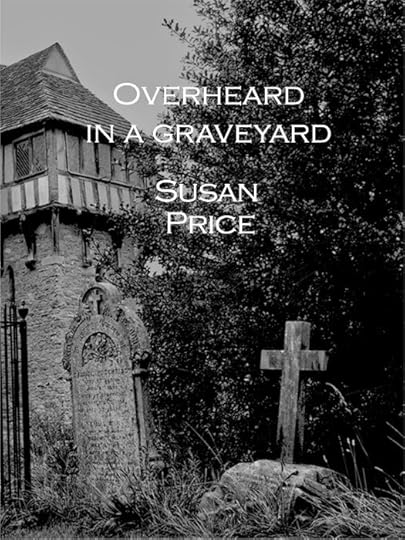
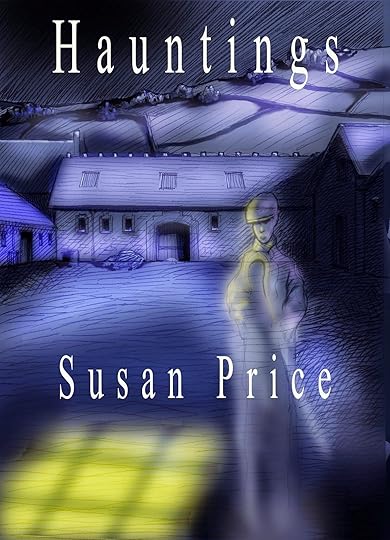
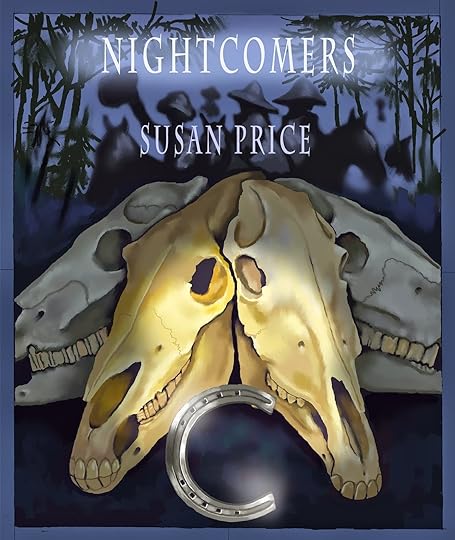
Overheard In A Hauntings Nightcomers
Graveyard
 A 'Spirit Photo': public domainSaturday, I shall miss it. And it's no use posting about Hallowe'en on Saturday, November 1, as that is, of course, All Souls Day, when the bogies and boggarts are all banished away - until sometime around Christmas, when they seem to come back, in time for our tradition of telling Christmas ghost stories.
A 'Spirit Photo': public domainSaturday, I shall miss it. And it's no use posting about Hallowe'en on Saturday, November 1, as that is, of course, All Souls Day, when the bogies and boggarts are all banished away - until sometime around Christmas, when they seem to come back, in time for our tradition of telling Christmas ghost stories.All fine by me, as I'm always ready to tell ghost stories.
I think I've blogged before about my family's stalwart efforts to remain sceptical and hard-headed despite all the yammering from the other world.
 Wikipedia: The Fairy Bridge
Wikipedia: The Fairy BridgeThere's my cousin, for instance, Alan Hess. Studied chemistry, worked in the computer industry and is a man of science. When he lived on the Isle of Man, and was told that, when crossing the Fairy Bridge, you always have to politely wish 'good morning,' to the fairies - or ill-luck will befall you.
Naturally, being a man of science, he scoffed. And the next time he drove across the Fairy Bridge, he called out - well, this is a family-friendly blog, so I won't say what he called out. But he was dreadfully rude to the fairies.
And lost control of the car, skidded across the road and ended up in the ditch. After that, he was always very polite to the fairies. But ask him about it now, and he maintains that it was coincidence. Pure coincidence.
But my main tale today is unseasonal. Davy and I once went for a walk along the river Teem. It was August, and about as hot as August can be. We walked through pasture and cornfields, climbing stiles and crossing bridges over small streams. It was beautiful, but we became very thirsty.

It was a long trek back to the pub where we'd left the car, but I saw a church spire rising over the tree-tops. The church was much nearer. "Where's there's a church, there's probably a village," I said. "Maybe a pub - or a least a shop where we could buy a bottle of water."
So we walked on, and came to a wooden bridge that would take us across the river to the church. The banks were thickly wooded, so we couldn't see anything of the church, or any neighbouring buildings, except the spire.
Once over the bridge, we came on an oddly desolate scene. There was no village - or any other building at all except the church.
But there had been a village. We could see the raised, roughly square and oblong platforms where the buildings had stood. You could see the streets that ran between them. Sheep wandered here and there, walking the sunken streets and clambering over what had been houses.
We wandered around the church, noting the changes to it, the walled up doors and windows. Davy said he'd like to see inside, so we went around to the porch.
I was struggling with the big iron door handle when Davy said, "Don't!" I looked over my shoulder at him, a bit puzzled. "There's a service going on," he said.

I was even more puzzled. I didn't think my hearing was that bad. I hadn't, and couldn't, hear anything except the sheep and the river. I put my head close to the door and listened. I could hear nothing from inside the church.
"No, there's not," I said, and tried again to open the door.
"There's somebody practicing on the organ then," Davy said. "We shouldn't disturb them."
I gave him a funny look. Was he having me on? There was no organ playing, and no other sound at all from inside the church. I opened the door - and immediately forgot about everything except investigating the place.
The church was dim, cool, silent and completely empty. It was a beautiful old place, and plainly dated to before the Reformation, as it had an old rood-screen, and steps that had originally led up to the gallery above it. We had a good poke around, and then went outside and wandered over the vanished village, speculating about what had happened there, before trudging back to the pub through the heat, and finally getting that drink.
It was only hours later, when we were home, that I thought back over the day and remembered that conversation in the church porch. I thought it over, remembering Davy's tone and manner. He hadn't been joking: I was certain of that. He had simply been stating something obvious to him: something - a service or an organ practice - had been going on in the church.
So I asked him about it. "There was someone in the church," he said. "I thought we shouldn't disturb them.But you never listen."
"But there wasn't anybody in the church," I said. "There wasn't a soul in there."
"Whoever it was must have gone out by the other door when we went in," he said.
I thought about that.
Nah. Not a chance.
There had been another door, but it had been big, old, heavy and closed. If, on hearing me push open the door, someone had jumped up from the organ and nipped out the other way, it would have been impossible for us not to have heard them. They would have had to scurry across a tiled floor, open a big, heavy door, and close it after them - all in an eye-blink.
I put this to Davy. "I heard music playing in the church," he said - again, a simple, plain statement of fact.
Knowing him as well as I do, I am completely convinced that he did hear a service or, at least, music playing. I am equally certain that there was no one in the church, and hadn't been for hours, and that there was no music playing.
Davy will not countenance any idea of ghosts. As far as he's concerned, he heard someone playing the organ, who then, in a moment, silently left the church as we stepped through the door (since the music apparently continued until we entered.)
I think I will just mention that although born in Edinburgh and raised in the Lowlands, Davy is of pure Highland descent. Just saying.
When I told my brother about this, he said, "Davy must have tinnitus." Typical Price.
I invite all my readers to contribute their spooky stories below, in honur of the season. Winter is coming.
And if you're looking for some suitably ghostly reading...



Overheard In A Hauntings Nightcomers
Graveyard
Published on October 24, 2014 16:00
October 17, 2014
A review of 'The Third Policeman' by Flann O'Brien
“Not everybody knows how I killed old Phillip Mathers,smashing his jaw in with my spade; but first it is better to speak of my friendship with John Divney because it was he who first knocked old Mathers down by giving him a great blow in the neck with a special bicycle-pump which he manufactured himself out of a hollow iron bar. Divney was a strong civil man but he was lazy and idle-minded. He was personally responsible for the whole idea in the first place. It was he who told me to bring my spade. He was the one who gave the orders on the occasion and also the explanations when they were called for.
I was born a long time ago…”
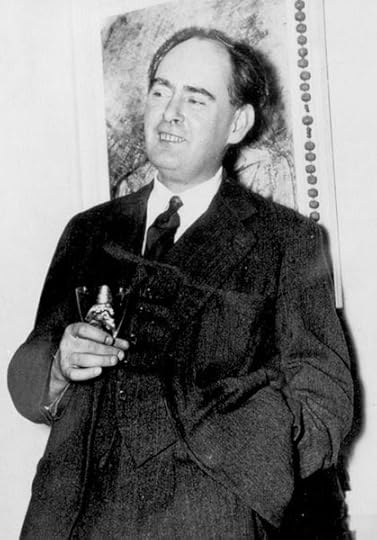 Flann O'Brien - real name, Brian O'Nolan That’s the opening of ‘The Third Policeman, ’ by Flann O'Brien, and it contains a psychology of psychopathy. The cool, unemotional account of a violent murder. The ranking of murder as equal in importance to the manufacture of a bicycle-pump, and the instant shifting of blame.
Flann O'Brien - real name, Brian O'Nolan That’s the opening of ‘The Third Policeman, ’ by Flann O'Brien, and it contains a psychology of psychopathy. The cool, unemotional account of a violent murder. The ranking of murder as equal in importance to the manufacture of a bicycle-pump, and the instant shifting of blame.Flann O’ Brien is known as a ‘comic writer.’ This is a ‘comic novel.’ It’s also a masterpiece.
It is very funny — and bizarre, poetic and despairing. It’s sinister. This is sinister, eerie, unsettling comedy.
I first read ‘The Third Policeman’ thirty years ago, and on
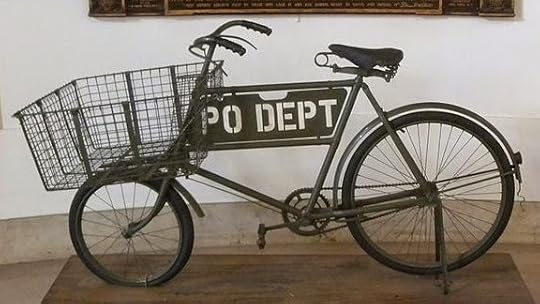 re-reading, I find that what I remembered are the most comic scenes — the atomic theory, as applied to bicycles and Irish roads; the men who are more than 75% bicycle; the delicate legal matter of deciding, when a man who is predominately bicycle, commits a murder, which should be hung? The man or the bicycle? And a coffin for a bicycle — 'an intricate piece of joinery.'
re-reading, I find that what I remembered are the most comic scenes — the atomic theory, as applied to bicycles and Irish roads; the men who are more than 75% bicycle; the delicate legal matter of deciding, when a man who is predominately bicycle, commits a murder, which should be hung? The man or the bicycle? And a coffin for a bicycle — 'an intricate piece of joinery.' I remembered the book as much more light-hearted than, on re-reading, it actually is. Funny, yes. Comic in the sense of ‘writing that holds human nature up to ridicule.’ But light-hearted? No.
I still enjoyed the scenes mentioned above — O’Brien’s inventiveness and audacity is second to none — but was more struck by the poetry of many passages, and how frightening much of it is. I’ve read ghost stories that don’t manage to convey such an sense of menace and ill-omen, as O’Brien does in a few lines.
The prose is beautiful. O'Brien could move, with ease, and often in the same passage, from the cant of the pub, to officialise, to poetry, all in lovely, rolling, perfectly balanced sentences.
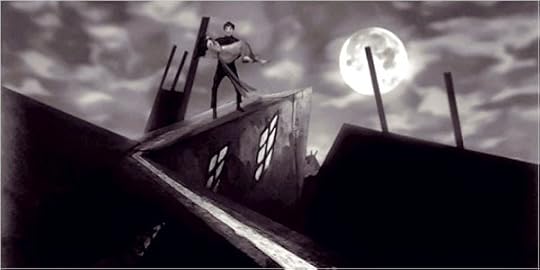 As I read, certain images kept coming into my mind, all drawn from ‘The Cabinet of Dr. Caligari,’ with its strange, skewed perspectives.
As I read, certain images kept coming into my mind, all drawn from ‘The Cabinet of Dr. Caligari,’ with its strange, skewed perspectives.“As I came round the bend of the road an extraordinary spectacle was presented to me. About a hundred yards away on the left-hand side was a house which astonished me. It looked as if it were painted like an advertisement on a board on the roadside and indeed very poorly painted. It looked completely false and unconvincing. It did not seem to have any depth or breadth and looked as if it would not deceive a child… What bewildered me was the sure knowledge deeply rooted in my mind that this was the house I was searching for… I had never seen with my eyes ever in my life before anything so unnatural and appalling and my gaze faltered about the thing uncomprehendingly as if at least one of the customary dimensions was missing, leaving no meaning in the remainder. The appearance of the house was the greatest surprise I had encountered since I had seen the old man in the chair and I felt afraid of it.”
This sense of dread, of nothing being quite as it should, pervades the book — and is part of the very narration, with its cool, detached, measured descriptions of terrors and shocks.
The nameless narrator — he can’t remember his own name — is an orphan who, due to an accident, has a wooden leg. (The book was written in the late1930s, before the development of modern prosthetics.) He has inherited a fortune, but by the time he is adult and returns to his farm, the money has been squandered by the caretaker, John Divney.
Both the narrator and Divney are keen to replenish the fortune — Divney so he can marry, and the narrator so he can publish a book on the scientist, De Selby, with whom he has become obsessed.
Asides and footnotes on De Selby make up a substantial part of the book, adding both to its oddness, humour and its cool, detached manner. They often discuss the competing interpretations and evaluations of De Selby’s life and work by other scholars, revealing — distantly — a world of academic spite and in-fighting.
Among De Selby’s theories is the notion that darkness is a contaminating vapour which emanates from holes in the earth, and contributes to disease because we inhale it. (This theory was once genuinely held in our world, before it was established that darkness is an absence of light, rather than a thing in itself.)
De Selby also argues that if we angle enough mirrors, to give enough successive reflections of ourselves, we could look into our past. He claims, by setting up mirrors, to have glimpsed himself at the age of eleven. He also claims that it would be possible to travel by sitting in a room and looking at a selection of photographs of our journey.
Many of these theories seem to be twisted, or over-literal understandings of relativity or quantum theory. Their twisting of time and space seems to relate to the literally twisted perspective in the description of the book’s world.
In pursuit of fortune, the narrator and Divney murder the old man, Mathers. Divney makes off with the cash-box, which he hides, saying they must spend none of the money until suspicion has died down.
Eventually, Divney reveals where he has hidden the box — in Mather’s house. They go together, one night, to the deserted half-ruinous murder house, and while Divney waits outside, the narrator goes in to fetch the box.
From this moment on, the book, already strange, becomes increasingly bizarre.
The narrator climbs through a window.
“I clambered through the opening and found myself,not at once in a room, but crawling along the deepest window-ledge I have ever seen. When I reached the floor and jumped noisily down upon it, the open window seemed very far away and much too small to have admitted me.”
He discovers that the cash-box has gone. And then:—
“I heard a cough behind me, soft, and natural yet more disturbing than any sound that could come upon the human ear. That I did not die of fright was due to two things, the fact that my senses were already disarranged and also that…the cough seemed to bring with it some more awful alteration in everything, just as if it had held the universe standstill for an instant…"
The narrator then takes tea with the old man he has murdered.
I don’t want to spoil the book by detailing any of the narrator’s adventures after that. Suffice to say that he meets with two enormous policemen, Sergeant Pluck and Constable MacCruiskeen, and also with his own soul. We learn about MacCruiskeen’s far from simple hobbies, and more about De Selby’s experiments.
We meet the brotherhood of one-legged men, visit Eternity and, eventually, meet the third policeman, Sergeant Fox.
If the book has a message, I think it might be that Evil is self-centred, self-aggrandising, futile and barren. And, possibly, that to be such a person is its own punishment, though the Evil are incapable of understanding that. They will go on their egoistical way, fancying themselves winners and superior, and never for a moment appreciating what they lack.
In fact, a lack of understanding is perhaps one of the themes of the book. The narrator obsessively studies the works of De Selby, trying to understand them, and wishing to make them better known - but his understanding of the world around him seems to have dwindled as his knowledge of De Selby increases. And De Selby is a model of intelligent obtuseness.
The Third Policeman is a book that blends a keen sense of wonder and beauty, with poetry, comedy, horror and despair.
I don’t think there is another book like it — except those others by Flann O’Brien, whose real name was Brian O'Nolan.
His first novel, At-Swim-Two-Birds (also a must-read) was published, and acclaimed, in 1939.
The Third Policeman was his second novel, and it was turned down. It wasn’t published until 1967, after the author’s death, when it was recognised as the wonderful piece of writing it was.
I wonder if, these days, it would be published at all?
Published on October 17, 2014 16:00
Susan Price's Nennius Blog
"I have made a little heap of all I've found..."
"I have made a little heap of all I've found..."
...more
- Susan Price's profile
- 71 followers



